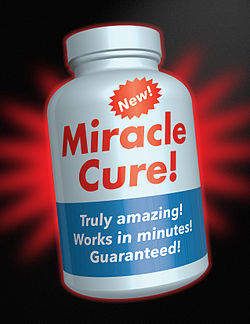Patent medicine
| Against allopathy Alternative medicine |
| Clinically unproven |
| Woo-meisters |
“”Grampa: Step right up, folks, and witness the magnificent medicinal miracle of Simpson & Son's patented revitalizing toniiic! Put some ardor in your larder with our energizing, moisturizing, tantalizing, romanticizing, surprising, her-prizing, revitalizing tonic!
|
| —The Simpsons, Grampa vs Sexual Inadequacy[1] |
Patent medicine typically refers to unproven remedies sold by traveling salesmen in the nineteenth and early twentieth centuries. They were sometimes also referred to as "snake oil" remedies.
Much of the same criticism applies to the 20th and 21st Century phenomenon of the "miracle cure" (examples including Miracle Mineral Solution, BX Protocol, and Antineoplastons, which are claimed to cure a wide range of serious and fundamentally different diseases without benefit of credible evidence).
These terms are still used today to describe the various substances of unclear efficacy sold for a profit through advertising. These cures are not always sold by malicious, deceptive con-men. Many promoters are true believers, making their claims even more convincing.
History[edit]
Patent medicines date at least from the 17th century. Peddlers were originally called mountebanks, and their quackery was so great that that word now solely means “fraudster” with the original specificity forgotten.[2]
During the nineteenth and early twentieth centuries, traveling "medicine shows" often promoted patent medicines in rural America — hucksters would proclaim the alleged miraculous benefits of these tonics between musical acts, freak shows, and other entertainment. Later, such preparations were often advertised on radio shows.
The term "snake oil" originates from this era. Genuine snake oil is a folk remedy used in traditional Chinese medicine, and one could buy it in the Chinatown areas of several large American cities. Patent medicine producers picked up on the idea and began producing their own "snake oil" products, although few if any of them contained genuine snake extracts.
Coca-Cola[edit]
Coca-Cola![]() originated in 1885 as a patent medicine, touting the benefits of wine (removed from the recipe in 1886 due to local prohibition laws), carbonated water, and (until 1903) cocaine. Its inventor, John Pemberton, claimed that the drink was an effective treatment for various conditions, including dyspepsia, headaches, impotence, and morphine
originated in 1885 as a patent medicine, touting the benefits of wine (removed from the recipe in 1886 due to local prohibition laws), carbonated water, and (until 1903) cocaine. Its inventor, John Pemberton, claimed that the drink was an effective treatment for various conditions, including dyspepsia, headaches, impotence, and morphine![]() addiction. Given that he passed due to stomach cancer aggravated by Morphine, and his son — who received control of the formula after his father died —succumbed to opium addiction, it appears it wasn't very good at the job.
addiction. Given that he passed due to stomach cancer aggravated by Morphine, and his son — who received control of the formula after his father died —succumbed to opium addiction, it appears it wasn't very good at the job.
Hadacol[edit]
Possibly the most popular patent medicine of all time (discounting Coca-Cola, which long ago abandoned all medical pretenses) was a short-lived concoction called Hadacol, cooked up by Louisiana state Senator Dudley J. LeBlanc in 1950. The "tonic" contained some B vitamins and iron, plus a 12% alcohol "preservative", which made it a popular source of booze in dry counties. Hadacol was heavily advertised throughout the south, with radio endorsements by entertainers such as Hank Williams, and even had a promotional caravan, often regarded as the last of the travelling "medicine shows",[3] but ultimately went bust by the end of 1951, due to huge advertising and tax debts, and due to a federal-court decision ruling that the manufacturers' claims that Hadacol was "an effective treatment and cure for scores of ailments and diseases" were patently false and misleading. The name lives on as that of a Missouri-based Country Rock band.[4]
Characteristics of patent medicines[edit]
- Extravagant claims, sometimes on the vague side to avoid prosecution
- Belief in a conspiracy to deprive patients of miracle cures
- Appeal to vanity: encourage consumer to "go with their gut"
- Giving people delusion of control over their illness, ignoring proven treatments that truly can give control.
- Appearance of plausibility, despite lack of evidence. Appeal to "common sense".
- Dismissal of experts/doctors in favor of "everyone can be an expert" (not in the Wiki sense, though, which demands peer review and documentation).
- Turn patient into expert salesperson/spokesperson for product.
- Play on fear, real or created.
- Anecdotal evidence of efficacy cited.
- Testimonials by those who claim to have been "cured".
- Many patent medicines were claimed to be virtual panaceas, curing or treating a long list of unrelated ailments.
- Distrust of the American medical establishment: Stressing that the nostrum has some overseas connection.
How to spot patent medicines[edit]
Advertisements and labeling for patent medicines will often feature a "Quack Miranda Warning" in the fine print.
In the 21st century United States, they are conveniently labeled with statements such as "This product is not intended to treat, cure, or prevent any disease" or "These statements have not been evaluated by the FDA".
Other countries with functioning government regulatory systems might have similar labeling; in countries that don't, you'll have to use your own bullshit detector.
References[edit]
- ↑ http://simpsons.wikia.com/wiki/Grampa_vs._Sexual_Inadequacy/Quotes
- ↑ Definition of “mountebank”, Merriam-Webster
- ↑ Miss Cellania, Hadacol, the Last of the Medicine Shows. Mental Floss, 2012.
- ↑ Bill Brownlee, KCUR's Band Of The Week: Hadacol. kcur.org, 27 September 2017.



